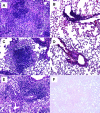In vivo adaptation of the Wayne model of latent tuberculosis
- PMID: 17283091
- PMCID: PMC1865751
- DOI: 10.1128/IAI.00918-06
In vivo adaptation of the Wayne model of latent tuberculosis
Abstract
Cultures of Mycobacterium tuberculosis grown under oxygen depletion conditions enter into a state of nonreplicating persistence that may reflect a physiologically latent state. When these cultures were harvested and injected intranasally into mice, no bacteria could be recovered from the lungs for about 3 weeks, but after that evidence of regrowth was observed. Preimmunization of mice with a panel of selected vaccine candidates slowed or prevented this event. This simple model has potential for identifying vaccines targeting latent tuberculosis.
Figures


References
-
- Betts, J. C., P. T. Lukey, L. C. Robb, R. A. McAdam, and K. Duncan. 2002. Evaluation of a nutrient starvation model of Mycobacterium tuberculosis persistence by gene and protein expression profiling. Mol. Microbiol. 43:717-731. - PubMed
-
- Bloom, B. R., and J. D. McKinney. 1999. The death and resurrection of tuberculosis. Nat. Med. 5:872-874. - PubMed
-
- Godfrey, H. P., J. V. Bugrysheva, and F. C. Cabello. 2002. The role of the stringent response in the pathogenesis of bacterial infections. Trends Microbiol. 10:349-351. - PubMed
-
- Honer zu Bentrup, K., and D. G. Russell. 2001. Mycobacterial persistence: adaptation to a changing environment. Trends Microbiol. 9:597-605. - PubMed
Publication types
MeSH terms
Substances
Grants and funding
LinkOut - more resources
Full Text Sources
Other Literature Sources

